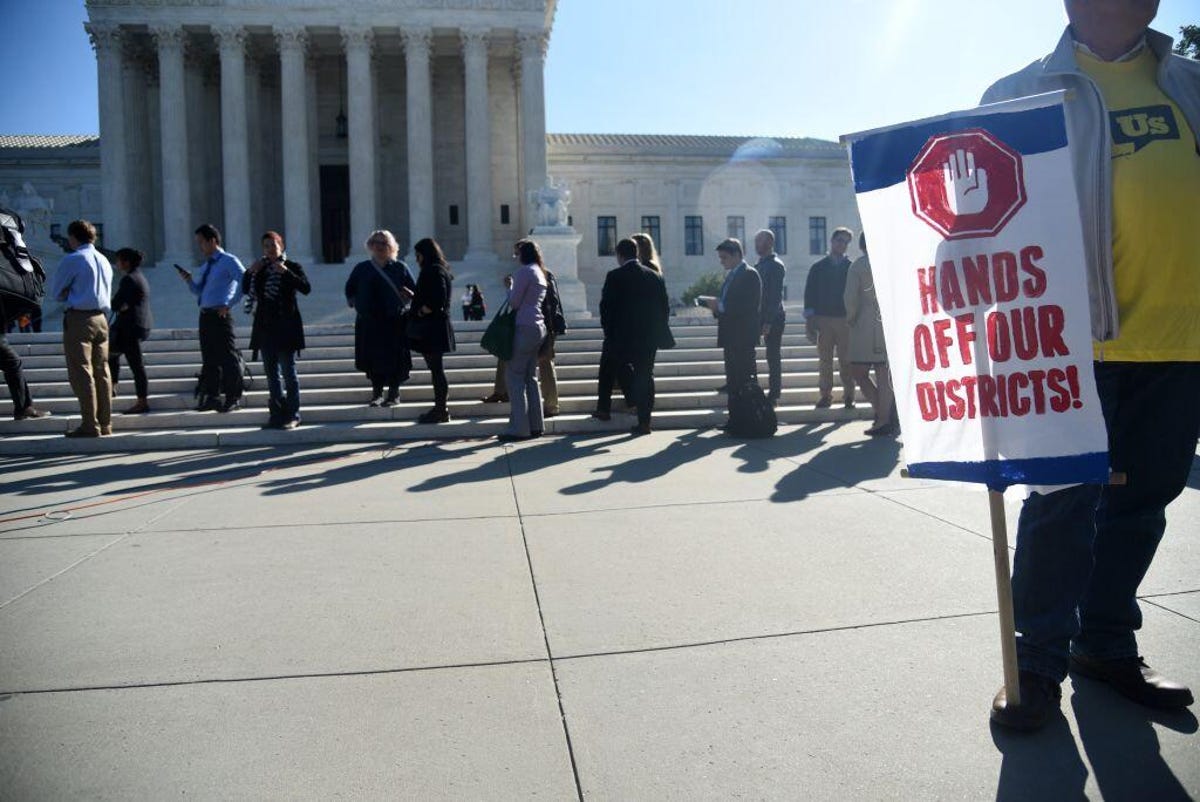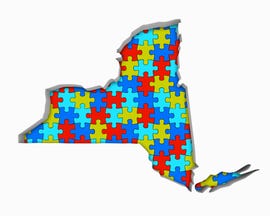Gerrymandering: What You Need to Know About the Threat Affecting Every Election – CNET [CNET]
What’s happening
As states redraw voter maps with 2020 census data, charges of gerrymandering have been leveled in dozens of districts.
Why it matters
Partisan redistricting can disenfranchise voters, skew election results and determine which party controls Congress.
What’s next
The Supreme Court will hear an Alabama gerrymandering case in October that could further dismantle the Voting Rights Act of 1965.
When the Supreme Court returns from its summer recess in October, the justices will hear arguments in Merrill v. Milligan, a case determining whether the state of Alabama is obligated to create a second Black-majority congressional district under the Voting Rights Act of 1965.
The legal tussle revolves around how lawmakers draw up voting districts, which can give one party an unfair advantage during elections. Civil rights organizations argued in a lawsuit filed last year that Alabama’s Republican-controlled legislature packed most people of color into the 7th District, then divvied up the remaining Black voters into the state’s six white-majority districts, diluting their ability to impact elections.

Partisan redistricting, known as gerrymandering, is one of the biggest political issues the court will face in the next session — and the subject of more than two dozen ongoing court battles. All 50 states are reworking district maps with information from the 2020 US Census. Changes to those maps will likely have a major impact on which party controls Congress after the November midterms.
Though gerrymandering has long been an issue in US politics, “the level of polarization today gives stronger incentives for both parties to use whatever edge they can,” said Nick Seabrook, a political scientist at the University of North Florida and author of One Person, One Vote: A Surprising History of Gerrymandering in America.
“The difference between a Republican or a Democratic majority is so extreme, there’s zero overlap anymore,” Seabrook said in an interview. “So the implications of who controls the House or Senate is so much more important.”
The rapid improvement in data collection and technology has also turned gerrymandering from a guessing game into a mathematical formula.
Here’s what you need to know about gerrymandering, including how it influences elections, how it’s changed in recent years and what impact it’s having on our democracy.
What is gerrymandering
Since the 1960s, state and local governments have had to redraw voting districts every 10 years, based on information gleaned from the most recent US census. All districts must have roughly the same population, but when officials intentionally skew the boundaries to favor one party or one type of voter, it’s considered gerrymandering.
The phrase “gerry-mander” was coined by early 19th century Federalists in response to the partisan redrawing of Massachusetts Senate election districts in 1812 to heavily favor the now-defunct Democratic-Republican Party.
Political cartoonist Elkanah Tisdale depicted one of Massachusetts’ distorted electoral districts as a mythological salamander in the Boston Gazette in 1812.
Getty ImagesMassachusetts Gov. Elbridge Gerry signed the bill approving the redrawn map, forever linking him to the controversial practice. The term is a portmanteau of his name and the mythological creature known as a salamander (not to be confused with the real-world amphibian of the same name).
Artist Elkanah Tisdale’s political cartoon in the Boston Gazette satirized Massachusetts’ contorted voting map by depicting one of the districts as a dragonlike creature.
What are ‘packing’ and ‘cracking’?
There are two main forms of gerrymandering: In the first, officials try to cram as many of the opposition’s voters as possible into a single district, a practice known as packing, to limit how many seats they control.
The opposite strategy, cracking, dilutes the other party’s base across so many different districts that they won’t be in the majority in any of them.
What’s the case coming before the Supreme Court?
Plaintiffs in Merrill v. Milligan — who include the ACLU of Alabama, the NAACP Legal Defense and Educational Fund, and Evan Milligan, executive director of the progressive nonprofit Alabama Forward — accuse Republican lawmakers of packing and cracking Alabama’s seven congressional districts to ensure that Black voters represented 56% of the 7th District, but no more than 30% in any other.
They claim that, despite representing nearly 28% percent of the state’s population, Black Alabamans can now only reasonably expect to impact elections in the 7th District — because of what the Brennan Center described as “high levels of racially polarized voting in the state.”
Their suit alleges that the partisan redistricting violated both the Voting Rights Act and the 14th Amendment’s Equal Protection Clause.
In January, a federal three-judge panel agreed, ordering Alabama to redraw its voter maps. But the state appealed and, in February, the Supreme Court agreed to hear the case and stayed the lower court’s order: As a result, even if the plaintiffs win, the contested map will be used in the 2022 midterm elections.
Gerrymandering has existed almost since the birth of our nation. Why is it such a big issue now?
To some extent, gerrymandering is a cyclical issue that arises every time voter maps are redrawn, said Michael Li, senior counsel for the Brennan Center for Justice at New York University Law School. Both parties have been accused of the practice.
“It’s been with us since the beginning of the country,” Li said in an interview. “It’s become more salient now, though, because it’s driving a lot of dysfunction in politics today.”
Historically, petitioners alleging gerrymandering could seek redress in federal court. Then, in 2019’s Rucho v. Common Cause, the Supreme Court ruled that weighing in on partisan redistricting was, as Chief Justice Roberts wrote in the majority opinion, “beyond the reach of the federal courts.”
“Federal judges have no license to reallocate political power between the two major political parties, with no plausible grant of authority in the Constitution, and no legal standards to limit and direct their decisions,” Roberts wrote.
His opinion was endorsed by the other members of the court’s conservative bloc: Justices Samuel Alito, Clarence Thomas, Neil Gorsuch and Brett Kavanaugh.
But Li called putting responsibility for policing voter district maps in the hands of state lawmakers “a disaster on multiple levels.”

Voting-rights activists say gerrymandering has become increasingly pernicious and sophisticated.
Olivier Douliery/Getty Images“It’s an unlevel playing field,” he said. “It allows for a lot of racial discrimination, in particular.”
District maps currently being drawn from 2020 census data are the first since Rucho. With Democrats maintaining only a slim majority in the House, creative redistricting in just a few critical districts could tilt control to the Republicans. And even in cases where courts are ruling maps are unconstitutional, there’s not enough time to redraw them before the midterms.
Seabrook says gerrymandering is killing democracy in the US.
“It’s creating an electoral system where the people in office aren’t representative of the popular will,” he said. “They represent whomever is in charge of redistricting.”
Entrenched gerrymandering is also allowing politicians to stay out of step with the electorate.
“It’s why issues like gun control, that have overwhelming support among the public, never go anywhere in Congress,” Seabrook said.
How has gerrymandering changed?
In the first half of the 20th century, lawmakers largely left district maps alone, ignoring demographic and population shifts that made districts woefully uneven. The situation often favored rural areas with dwindling populations but a high percentage of white voters.
In two 1964 decisions, Reynolds v. Sims and Wesberry v. Sanders, the Supreme Court declared that states must use the most recent census count to redraw state and federal districts and maintain equally represented populations.
“So in fixing one problem, they created a whole new one,” said Seabrook. “Politicians realized they could really put their thumb on the scale.”
In the past, lawmakers could only estimate constituents’ voting habits, but the system has gotten more sophisticated, according to both Li and Seabrook. “Now we know so much more about voters — we can know where you shop, what you post on Instagram, even how strong a voter you are,” Li said. With computers, “you can draw thousands of maps or redraw lines a million different ways.”
Creating districts where the results are all but guaranteed “fuels the feeling the system is rigged,” Li added.
Some of the biggest redistricting battlegrounds
At least 31 legal challenges have been brought against redistricting maps this legislative cycle, the majority by Democrats over maps drawn by Republican-dominated legislatures. Several cases have broad implications.
North Carolina
In February, the North Carolina Supreme Court rejected the district maps drawn up by the Republican-controlled legislature as partisan gerrymandering and ordered both state legislature and congressional maps redrawn.
The state has appealed the case, Moore v. Harper, to the Supreme Court. The justices are now considering whether to grant a review of the case.
“This case presents an exceptionally important and recurring question of constitutional law, namely, the extent of a state court’s authority to reject rules adopted by a state legislature for use in conducting federal elections,” Alito wrote in the decision to deny a stay of the lower court’s order that was joined by Thomas and Gorsuch.

New York’s voter district map was struck down as a Democratic gerrymander in April.
Getty ImagesIf the court grants review, Moore v. Harper could be argued in the next Supreme Court session.
New York
With Republicans controlling more statehouses, gerrymandering can seem like a one-sided problem. But Democrats have also played the same games. When an independent commission established to draw up districts in New York couldn’t agree on a set of maps, the Democratic-controlled legislature stepped in to draw its own lines, which Democratic Gov. Kathy Hochul quickly signed into law.
In April, the New York Court of Appeals struck down the legislature’s district lines as a Democratic gerrymander and appointed a special master to devise a new, more balanced map.
Analysts say how the districts are carved up could be a critical factor in which party takes the House of Representatives in November, since New York lost a seat after the last census reshuffle.
Meanwhile, the legal battle meant congressional and state senate primaries had to be moved from June 28 to Aug. 23 to give time for new maps to be redrawn. And candidates already on the campaign trail aren’t sure which neighborhoods they’ll ultimately be representing.
Ohio
As of May, the state’s high court has rejected five proposed legislative maps.
Lawmakers will have to keep at it but, in the meantime, a federal court allowed a map that’s twice been declared an unconstitutional partisan gerrymander to be used for the fall midterms.
Florida
In May, a state circuit court judge struck down a new north Florida congressional district map drawn by Republican Gov. Ron DeSantis “because it diminishes African Americans’ ability to elect candidates of their choice.”
DeSantis had dismantled Florida’s 5th District — which stretches from Jacksonville to Tallahassee and is 48% Black — cracking it into four new Republican-heavy districts, each with a much smaller segment of Black voters.
Seabrook, who lives in Jacksonville, said Florida has had three decades of Republicans being in charge of redistricting.
“It just wears away the other side and discourages people from running for office,” he said. “We now have a state Supreme Court that is made of seven Republican appointees. The Democratic Party in Florida is pretty much a nonentity at this point.”
An appeals court later paused the ruling on DeSantis’ map, but in June the state Supreme Court declined to review the case. That means the governor’s redistricting plan will be used for the 2022 congressional elections.
It gives Republicans a 20-8 advantage in the state’s congressional delegation, the Guardian reported, and would likely give the GOP an additional four seats in the House.
What’s the solution to gerrymandering?
In Congress, the John Lewis Voting Rights Advancement Act of 2021 would have restored parts of the Voting Rights Act of 1965, including the need for states with a history of voter discrimination to receive approval from the Department of Justice or a federal court before redrawing voting maps.
The bill passed the Democrat-controlled House in August 2021 but was blocked by Senate Republicans that November.
Seabrook believes the answer involves taking redistricting out of the hands of lawmakers altogether.
“The main problem with gerrymandering today is that politicians are drawing maps that either favor themselves or the party they belong to,” he said. The system “favors incumbent protection and partisan interest when it should be shifted toward protecting community interests.”
He advocates for impartial citizens’ commissions, like the ones used by California, Colorado and Michigan.
“Anyone can apply and they’re not appointed or tied to legislators,” Seabrook said. It’s a strategy employed in his native UK, as well.
Bills to install citizens’ commissions have been introduced in numerous states, including North Carolina, where lawmakers are considering The Fair Maps Act, which creates an independent redistricting process.
“It doesn’t always produce districts that are 100% perfect, but they’re impartial,” Seabrook said. “If we did that in every state in the US, it would keep more seats competitive.”

![gerrymandering:-what-you-need-to-know-about-the-threat-affecting-every-election-–-cnet-[cnet]](https://i0.wp.com/upmytech.com/wp-content/uploads/2022/06/73808-gerrymandering-what-you-need-to-know-about-the-threat-affecting-every-election-cnet-cnet.jpg?resize=800%2C445&ssl=1)
![arkane-dev-reveals-first-look-at-marvel’s-blade-concept-art-[game-informer]](https://i0.wp.com/upmytech.com/wp-content/uploads/2023/12/157979-arkane-dev-reveals-first-look-at-marvels-blade-concept-art-game-informer.jpeg?resize=390%2C205&ssl=1)
![a-future-without-fraud:-the-latest-advances-in-fintech-that-keep-your-money-safe-[venturebeat]](https://i0.wp.com/upmytech.com/wp-content/uploads/2022/04/61262-a-future-without-fraud-the-latest-advances-in-fintech-that-keep-your-money-safe-venturebeat.jpg?resize=390%2C205&ssl=1)
![how-to-successfully-deploy-robotics-within-an-organization-[venturebeat]](https://i0.wp.com/upmytech.com/wp-content/uploads/2022/06/72619-how-to-successfully-deploy-robotics-within-an-organization-venturebeat.jpg?resize=390%2C205&ssl=1)